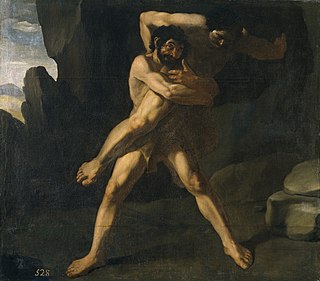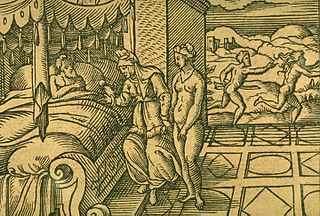Related Research Articles

Antaeus, known to the Berbers as Anti, was a figure in Berber and Greek mythology. He was famed for his defeat by Heracles as part of the Labours of Hercules.

In Greek mythology, Cinyras was a famous hero and king of Cyprus. Accounts vary significantly as to his genealogy and provide a variety of stories concerning him; in many sources he is associated with the cult of Aphrodite on Cyprus, and Adonis, a consort of Aphrodite, is mentioned as his son. Some scholars have proposed a connection with the minor Ugaritic deity Kinnaru, the god of the lyre. The city Cinyreia on Cyprus was believed to have taken its name from Cinyras. According to Strabo, he had previously ruled in the city of Byblos in Phoenicia.

In Greek mythology, the Heliades also called Phaethontides were the daughters of Helios and Clymene, an Oceanid nymph.

Pirithous, in Greek mythology, was the King of the Lapiths of Larissa in Thessaly, as well as best friend to Theseus.
In Greek mythology, Thamyris was a Thracian singer. He is notable in Greek mythology for reportedly being a lover of Hyacinth and thus to have been the first male to have loved another male, but when his songs failed to win his love from the god Apollo, he challenged the Nine Muses to a competition and lost.
In Greek mythology, Acherusia was a name given by the ancients to several lakes or swamps, which, like the various rivers called Acheron, were at some time believed to be connected with the underworld, until at last the Acherusia came to be considered to be in the lower world itself.
In Greek mythology, the name Toxeus or Toxius refers to the following individuals:
Euryalus refers to the Euryalus fortress, the main citadel of Ancient Syracuse, and to several different characters from Greek mythology and classical literature:
Evenor is the name of a character from the myth of Atlantis and of several historical figures.

In ancient Greek religion and myth, the Anemoi were wind gods who were each ascribed a cardinal direction from which their respective winds came, and were each associated with various seasons and weather conditions. They were the progeny of the goddess of the dawn Eos and her husband Astraeus.

Gangaridai is a term used by the ancient Greco-Roman writers to describe a people or a geographical region of the ancient Indian subcontinent. Some of these writers state that Alexander the Great withdrew from the Indian subcontinent because of the strong war elephant force of the Gangaridai.
Agamede was a name attributed to two separate women in classical Greek mythology and legendary history.
In Greek mythology, the name Anthus may refer to:

A corolla is an ancient headdress in the form of a small circlet or crown. Usually it has ceremonial significance and represents victory or authority.
In Greek mythology, Methe is the spirit and personification of drunkenness. She entered the retinue of Dionysus and was mentioned in association with the god or other companions of his. Methe was the daughter of Dionysus in some accounts.
In Greek mythology, Pandaie or Pandae was a daughter of Heracles whom he fathered in India.
In Greek mythology, the name Hyperbius may refer to:

In Greek mythology, Philyra or Phillyra was one of the 3,000 Oceanids, water-nymph daughters of the Titans Oceanus and Tethys.

A chaplet is a headdress in the form of a wreath made of leaves, flowers or twigs woven into a ring. It is typically worn in festive occasions and on holy days. In ancient times it also served as a crown representing victory or authority.
In Greek mythology Smilax was the name of a nymph who was in love with Crocus and was turned into the plant bearing her name. Ancient sources with information about her and her tale are few and far in between.
References
- Pliny the Elder, The Natural History. John Bostock, M.D., F.R.S. H.T. Riley, Esq., B.A. London. Taylor and Francis, Red Lion Court, Fleet Street. 1855. Online version at the Perseus Digital Library.
- Pliny the Elder, Naturalis Historia. Karl Friedrich Theodor Mayhoff. Lipsiae. Teubner. 1906. Latin text available at the Perseus Digital Library.